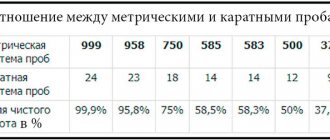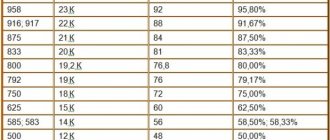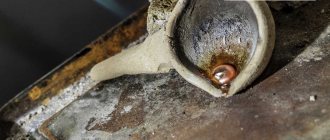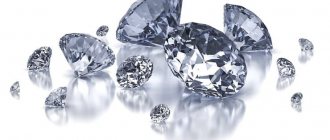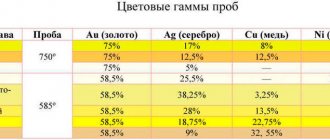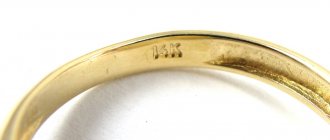Gold was the first noble metal discovered by man, and today it has found application in many areas. Gold has been the most successful market in the jewelry industry. At the same time, there is a gradation of the value of the metal. Every woman, receiving a jewelry gift from a man, will definitely pay attention to the fineness or carats. This indicator informs about the amount of pure precious metal used to make jewelry. How can one learn to evaluate the purity of the alloy and quality by the mark on the product?
Meaning and origin of the word "carat". Composition of gold in bullion and consumer goods
The word carat translated from Latin means “carob.” Its origin is Eastern countries. The value of the plant is represented by its seeds, which became the prototype of the unit for measuring the purity of gold. Previously, they were used to measure the weight of expensive stones.
Carat of gold
This valuation method was not the most reliable, so traders from different countries decided to equate 1 carat to 205 mlg. Later, the established weight was reduced for convenience to 200 mg. And today, this measuring system remains the only one for assessing precious stones throughout the world.
Over time, traders began to value not only stones as valuable seeds. The gold carat allowed us to determine the quality of rings, earrings, bracelets and other jewelry. The maximum gold content according to the grading system is 24 carats.
This is exactly what is indicated on bank bullion. However, pure gold is very soft and unsuitable for creating various products. Therefore, impurities are added to it to improve consumer qualities. This is where the carat value of the products becomes important, showing the optimal ratio of gold and alloy.
Why carat weight is important
The weight of a gemstone is a major factor in its price. Next come other characteristics: color, transparency, absence of inclusions. For example, a 0.50 carat diamond with high performance characteristics will cost slightly more than a 0.75 carat stone with flaws. Within a certain price range you can always find a number of weight and quality combinations.
Since large gemstones are much rarer in nature than small ones, their value increases significantly based on weight. A 1.00 ct stone will cost more than twice as much as a 0.50 ct diamond of comparable quality. As the size increases, both the diameter and depth of the stone increase. This is why the diameter of a one-carat diamond (approximately 6.5mm) does not appear to be twice the width of a 0.50ct stone (approx. 5mm).
If several diamonds are used in the manufacture of jewelry, their weight is summed up and indicated by one number. For example, the earring label states that the diamond inserts weigh 1.00 carats - this means that each earring contains 0.50 carats of stone. The weight of emeralds, diamonds or sapphires in one product is indicated separately.
A gran is attached to a karat. This is a non-systemic unit accepted in gemology for measuring the mass of pearls. 1 grain of pearl is equal to 0.25 carats or 0.05 grams.
Gold purity grading systems
In the history of the jewelry industry, there were 4 systems for assessing the purity of a gold alloy: lot, spool, metric, and carat. However, today only the last 2 are relevant, with the help of which the amount of precious metal can be measured.
Metric system and samples
Russia and some post-Soviet states use a metric system for assessing metal purity. According to it, the sample shows the amount of pure gold in 1000 parts of the alloy. In other words, how many milligrams of gold does 1 gram of alloy contain?
The following acceptable indicators have been approved: 375, 500, 585, 750, 900, 916, 958, 999. However, the range is not limited to these samples, they are only frequently used.
Stamps on precious items
Carat system. Carat value
This system includes the following values: 9, 12, 14, 18, 22, 23, 24. 24 karat gold is considered pure, containing a minimum of impurities. The carat of gold shows the amount of pure metal in the alloy relative to 24 carats. The system is used by world jewelry experts to determine the percentage of pure metal in products.
In the USA and European countries, the purity of only gold alloys is measured in this way; it is not applicable to other metals.
Spool system of Tsarist Russia
For more than two centuries, Russia used a spool measurement system to assess the purity of precious metals. With its help, silver and gold were assessed, comparing them to the number of spools. And only in 1927 it was replaced by metric measurement.
The spool unit, like the metric one, helps determine the ratio of pure precious metal and alloy. Its basis is 96 units - spools. Precious metal 999 corresponds to 96 spools.
To convert the spool valves to the usual value you need to: divide the spool indicator by 96 and multiply by 1000.
Ingots 999.9 fine
Composition of popular gold alloys
The most common variant of gold in Western countries is 14 karat alloy. It corresponds to our 583rd or 585th sample, which is the most common in the post-Soviet space. This gold alloy has good casting and strength characteristics, which makes it possible to create jewelry from it for everyday wear.
Depending on the number of certain ligatures in the composition, 14 carat gold can have different shades. For example, if it contains about 36% silver and 5.5% copper, then the master will end up with gold jewelry with a greenish tint. If silver in the alloy accounts for 18.3% of silver, and copper about 23.5%, then the popular pink color can be created. But if the amount of copper is increased to 33.5%, and silver is reduced to 8.4%, then a gold product will come out with a distinct reddish tint.
White gold, popular in the West and in our country, is most often made from 14-karat and 18-karat alloys. In the first case, the alloy contains about 23–28% silver, 13–18% palladium or 17% nickel. Copper is found in different versions, but not more than 16%, as well as zinc - about 9%. But in 18-karat gold the following alloys are found: silver (7-15%), palladium (14%), nickel (4%) or zinc (2-5%), copper (15%), nickel (7-16 %). In more expensive options, zinc and copper are not added to the alloy, and rhodium and platinum are used as alloys, but the cost of such jewelry is much higher. In addition, not all countries add nickel to white gold. For example, in the European Union countries, the use of this ligature in jewelry is prohibited at the legislative level, since in some cases it causes allergic reactions in people.
Jewelry with a carat value of 10 or less corresponds to our 375 grade. This alloy contains only 37.5% pure gold, and the lion's share is copper - about 49%. Also, the alloy may contain about ten percent silver and about four percent palladium. Wedding rings are made from similar alloys, the prices of which are affordable. But due to the low content of precious metal in them, such products are not in great demand.
When choosing jewelry marked according to the karat system, you need to be able to recognize real gold and gilding, since it is easy to get confused in their designations.
If on the surface of the jewelry you have chosen you see numbers with a capital letter “K”, for example, “18K”, this means that this means that this is a high-grade gold product corresponding to the 750th standard. But if you find numbers with the letters “KGP” on the jewelry, you should be alert, since this is a gold-plated object. For example, if you see the marking “22KGP”, this means that the gilding contains 916-carat gold, but the item itself is made of a different metal. The abbreviation itself, following the numbers, means the English phrase “karat gold plated”, which translates as “covered with gold in so many carats”.
Carat and fineness of standard gold on the world market
The carat rate for valuing jewelry is used by America, Great Britain, Switzerland and other European countries.
The gold standard on the world market is considered to be 24 carats. Every day, the price of gold is determined on the precious metals exchange precisely in relation to bank bullion, which consists of 99.99% of the precious metal. The purity of such gold reserves is 999.
Using a simple example of calculating the ligature, you can understand how the standard and carats relate. To find out how much ligature the alloy contains, you need to subtract the number of carats on the stamp from 24k. 12k jewelry uses 12k other metals. This simple translation allows us to equate carats to a metric indicator, in which 1000 grams (24k) consists of 500 grams of gold (12k) and 500 grams of alloy (12k). Accordingly, 12k = sample 500.
Diameter and corresponding weight
For round diamonds, a relationship between mass and size was revealed. Based on the diameter of the stone, you can roughly estimate its carat weight. Since an ideal ball shape is impossible, and jewelers create 57 or more faces, the relationship is complex and is calculated by the square of the diameter multiplied by the height of the crystal and a coefficient of 0.0061. To avoid unnecessary calculations, special tables of ratios have been created:
| Diameter, mm | Weight, carat |
| 1,0 | 0,005 |
| 2,0 | 0,03 |
| 3,0 | 0,10 |
| 4,1 | 0,25 |
| 5,2 | 0,50 |
| 6,2 | 0,85 |
| 7,0 | 1,25 |
| 8,2 | 2,00 |
| 9,0 | 2,50 |
| 10,2 | 4,00 |
| 11,0 | 5,00 |
| 12,4 | 7,00 |
| 13,0 | 8,00 |
However, with a cut that is at least slightly different from the round one, the ratio will change within limits unacceptable for jewelry precision. This means that for other shapes (close to round) there are formulas:
- for profile: product of height, length, width and coefficient 0.0083;
- for oval: the product of the squared diameter, height and coefficient 0.0062.
Thus, the profile shape, which is also called “Princess,” is the most profitable, since, as follows from the value of the coefficient, the consumption of waste material for it is the least.
Formula for converting carats to fineness
The bank bullion consists of 99.9% pure precious metal. In Russia, the metric system with a marking mark in the form of a sample has been officially adopted for the evaluation of jewelry. Any indicator of other measurement systems can be easily converted to obtain the share of the precious metal used.
To determine which metal sample corresponds to the specified number of carats on the product, you can use a simple formula:
carats / 24 * 1000
The resulting figure will be in the range of values of the metric system.
Early variations
The unit of mass that is used now did not always exist in this form. The following options were previously used:
- English carat. The history of this unit originates from the ancient gran (gr), based on the weight of an average grain of barley. The English variety of gran was subject to the troy system, and when converted to the one currently used, it was equivalent to approximately 64.799 grams. Accordingly, the carat, calculated as 3 and 17/101 grains, was equal to 205.3 mg. This unit was not indivisible; in everyday life, measures from ¼ to 1/64 carats were used - the so-called jewelry grains.
- Arabic carat (qirat). In Arab countries, the jewelry unit was even more unstable. It was tied to the mithqal and dirham. But since these measures of mass were simultaneously considered monetary units, how many grams are in 1 carat depended on the country. In Iraq the value was 223.2 mg, in Asia Minor - 204 mg, Syria and Mecca - 195 mg. In Egypt, qirat was correlated with local measures of weight, namely shamuna and bakila, and was also equal to 195 mg.
Thus, how much 1 carat weighs also depends on what system of measures it is tied to.
Table: ratio of different rating systems
| System | Carat | Metric |
| Zolotnikovaya | ||
| 36 | 9 | 375 |
| 48 | 12 | 500 |
| 56 | 14 | 585 |
| 72 | 18 | 750 |
| 88 | 22 | 900 |
| 92 | 23 | 958 |
| 96 | 24 | 999 |
Gold ring with a stamp 56
Origin
The place of origin greatly affects the value of gemstones. Professionals can determine where emeralds are mined by color. Colombian have additional yellow tones, blue shades are present in Zambian gems.
Stones extracted from Colombian deposits are in high demand among buyers. But this indicator does not mean that the properties of emeralds from Colombia are superior to stones from Zambia. It's all about advertising here.
After extraction, the gems are processed to correct flaws and are brought to near perfection. It is extremely rare to find an emerald without flaws (cracks) in nature. If this happens, then its cost is incredibly high, since it is considered almost a pure emerald.
At affordable prices, emerald minerals with an impregnated defect are available for sale, which is not visually noticeable. But their beauty does not diminish from this. Craftsmen often use cedar oil as an impregnation.
Where to find the stamp, sample and manufacturer's mark on the product
Each ring, bracelet, chain and other jewelry must correspond to the standard, one of the existing rating systems. Any jewelry salon can only sell jewelry that bears the state hallmark. This imprint is called a name tag and includes numbers and letters. The numbers indicate the year of manufacture and sample. The letter symbol indicates the manufacturer.
Any jewelry is sold with a label, details: name of the manufacturer, name of the jewelry, code, article number, weight. Additionally, the size of the item and the name of the inserts, if any, are indicated. According to GOST, the label is attached to the products with white thread and a seal.
Marking on a product is regulated and carried out only by the Assay Chamber of the Ministry of Finance of the Russian Federation. The state mark can be affixed using a laser or minted. The presence of such a sign indicates the authenticity of the jewelry and the passage of appropriate checks.
Includes a sample, a sign of identification, which are applied in one or different images. The ID symbol can be an image of a star with a hammer and sickle, characteristic of Soviet gold, or the head of a woman in a kokoshnik, turned to the right.
The history of measuring the weight of minerals and precious metals and what is the cost of one carat
Today we are accustomed to measuring various bulk and solid bodies in grams and kilograms. However, several thousand years BC, people used completely different units to measure weight. And to determine the weight of a diamond or other gem, equal-arm scales were used.
Weights made of ordinary stone or ivory (from rich merchants) were placed on these scales. For the people of Israel, the Mosaic Law even stated that merchants were required to have precise weights corresponding to a certain weight. Failure to comply with the Law carried with it punishment, which could be expressed in administrative penalties.
The most common units of weight in Israel were the shekel (11.4 grams) and the talent (34.2 kilograms). However, when foreign merchants began to import diamonds into the country, it became necessary to introduce a smaller measure to weigh small stones. Then such a unit of measurement as the hera appeared.
What was one hera equal to? It corresponded to fifty-seven hundredths of a gram or approximately three carats. Of course, not all stones were of this size, but still the ger made it possible to measure rough diamonds more accurately. The importation of precious materials into the country peaked between 1030 and 970 BC, when the nation of Israel was ruled by King Solomon and then his son. At that time, the annual income of the royal treasury amounted to over fifty billion dollars in modern monetary equivalent. Even an ordinary resident could have precious gems and gold in his everyday life.
In Persia, a darik was used to check mass, which weighed 5.6 grams. It satisfied the needs of the body kit of almost all materials. Closer to the first century AD, the Roman Empire began to rise on the world stage. In its monetary circulation there was a measure of weight called a denarius, which was 3.85 grams. Interestingly, Greek culture was dominant at that time, and the Greek language was common throughout the empire. However, the monetary measurement of the mass of jewelry was exclusively Roman.
It is worth noting that one carat, as a unit of measurement, already existed during the times of the Greek and Roman Empires. However, it was popular only in Asian countries. What is a carat? Carat was the name given to the seeds of the pod tree, which were always the same in weight. Since they were always at hand, they were easy to use on the road. Merchants who traded gems always had these seeds.
The cost of 1 carat greatly depends on the quality of the stone, its color and size.
Why is it better to trust the sample on the product?
Each piece of jewelry of domestic or imported origin must have the necessary markings. Imported gold jewelry is always marked with carats and the word “gold”. Certificates for trading are required.
It is important to correctly read the existing name tag, especially on products brought from other countries. After all, most of such jewelry is gold-plated jewelry or silver, which is also indicated by the presence of appropriate markings. Moreover, the price of these jewelry may correspond to the original.
Any gold jewelry brought for sale in the Russian Federation requires assaying. Then the fineness is indicated along with the carats.
Criteria for determining quality
To choose the best stone, you need to know how to check its quality. This can be done by specialists with knowledge in this field. The check is performed using professional equipment. But there are basic characteristics that determine the value of an emerald, knowledge of which will help everyone when choosing a stone.
What criteria are considered decisive?
- Color.
- Transparency.
- Origin.
- Cut.
- Weight and size.
Knowledge of all these characteristics will be useful when purchasing products with emeralds.
Determining the carat value of a product using the acid method. Instructions
Using simple methods, you can establish the authenticity of gold. But how to determine the sample or carat? It is difficult to do this at home, since you will have to purchase special reagents. A jeweler can use the acid method to determine the purity of items. It is also used in pawnshops, buying precious items. To do this, a small scratch is made on the jewelry, onto which a little acid is dripped, which reacts with the noble metal. Based on the result, you can determine how many carats the product corresponds to.
Step by step test execution:
- Clean the product from dirt and make a small scratch.
- Take reagents intended for different carats. First, apply a drop from the bottle with the lowest reading onto the scratch. If the carat value is higher than that indicated on the bottle, the color of the alloy will not change. Then the experiment must be repeated until a match is found.
- When the carat value of the reagent matches the precious metal, the location of the damage will slightly change the shade. If the value of the jewelry differs by several carats, the scratch will be covered with light rust. If the alloy has a quality several carats higher than indicated on the bottle, then the scratch will dissolve and disappear.
Diamond weight
Another common use of the carat is to express the weight of diamonds, that is, cut diamonds. This mineral is highly valued, and the better its characteristics, the more expensive it is. Quality is assessed based on four criteria:
- Cut. The lines must be geometrically proportional. Previously, this was achieved by grinding and grinding one of the edges. Subsequently, jewelers produced other cuts of different shapes. The goal of these developments was to find an ideal option that would completely reflect the light inside the stone. The profile shape created by 13-year-old jeweler Arpad Neji became popular.
- Purity. The most significant indicator, depending on the number and size of cracks, inhomogeneities, foreign impurities and other defects in the mineral. It is determined by examining the diamond using a magnifying glass with tenfold magnification. If there are no flaws at all, the stone is called a pure diamond.
- Color. If the stone is transparent with faint shades of yellow and brown, it is characterized as colorless. If a diamond has pink, blue, green or other distinct colors, it is called fancy.
- Weight. The weight of 1 carat in grams largely determines the price of a diamond. The cheapest stones are small stones that measure less than 0.29 carats. Medium ones are valued higher - from 0.30 to 0.69 carats. The most expensive ones are large ones, over 0.7 ct.
Diamonds weighing more than 10 carats are especially valuable and receive their own names. The largest representatives weigh over 500 carats. Thus, a 106-gram colorless stone with the poetic name “Star of Africa” has a mass of 530.2 carats and is one of the largest diamonds in the world. It represents the largest of 105 fragments of the Cullinan Diamond, weighing 3,106 carats when found. Surpassing the “Star of Africa” is the yellow-brown “Golden Jubilee” weighing 547.67 carats.
Category: question-answer
There are many tips on the Internet on how to test gold. How to determine the purity or carat of gold?
Expert opinion
Pribrezhny Gennady Valentinovich
Jeweler 6th category
Each piece of jewelry sold in Russia must have a hallmark and a hallmark. If there are no marking symbols, this may indicate restoration, alteration of the jewelry, or rare single hand-made work in which a mark is not placed. Then, if you have special reagents or other tools, you can determine the sample yourself. But it is better to visit a specialist who can accurately determine the authenticity and composition of the gold. The best decision would be to buy in jewelry stores with a good reputation and guarantee, for example, in the Sunlight chain, Almaz Holding, MYuZ.
How to convert carats into carats when buying jewelry abroad?
Expert opinion
Grishanov Mikhail Petrovich
Jeweler, director of the Grishanov and Co. workshop
When buying imported jewelry abroad, it is important to pay attention to the stamp and the presence of other signs indicating authenticity. In rare cases, a foreign alloy may not be as pure as the corresponding sample. You can bring this indicator to the usual standard using the formula: carats / 24 * 1000.
How many carats is pure gold?
Expert opinion
Pribrezhny Gennady Valentinovich
Jeweler 6th category
The precious metal acquires a white color by adding more silver or palladium to the alloy. Today it is a popular alloy with hallmarks: 585, 750, 900. Thus, the carats of white metal are fully consistent with those of yellow, respectively.
Gold granules
How much is a carat of gold in grams?
Expert opinion
Grishanov Mikhail Petrovich
Jeweler, director of the Grishanov and Co. workshop
It is believed that in 1k there is 0.2 grams. But this indicator is used to measure the weight of precious stones exclusively. There is even a special table indicating the carat of stones with the corresponding weight.
How to compare stone prices
There are criteria for determining the cost of a stone:
- Shade and color. Color intensity can greatly influence the price of a gem. Stones that are too dark or light will be lower in price; admixtures of different colors also reduce the cost. The most valuable stones will be those with deep, bright shades.
- Processing (cut, shape). The type of cut reveals the stone's ability to play with light. The better the work is done, the more the gem will shine and the more valuable it will be.
- Transparency. Natural stones are rarely completely free of defects; the most transparent ones are an exception and are sold at auctions at high prices.
- Size and weight. This criterion affects stones of good quality more; for low-grade gems, size matters much less. The size may be different for stones of the same weight, but it is the mass that plays a big role. The cost of a good diamond of 0.25 carats will be about 160,000 rubles, and 0.5 ct – already about 300,000 rubles.
Attention! Expensive stones must have a quality certificate.
Why are gemstones measured in carats?
